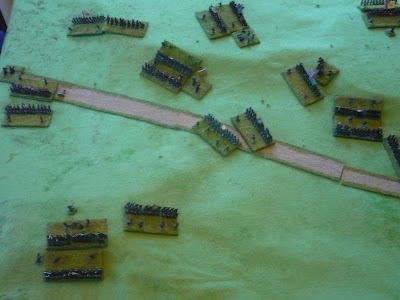The first battle is an encounter battle between elements of SS Kampfgruppe Weidinger and the 7th Seaforth Highlanders. I used the WRG 1925 - 1950 rules along with the Threat Generation System from Miniature Wargames 373.
I took the Scots and used the cards to randomaly generate the German forces.
British Orbat:
1 Platoon of British Infantry
2 additional rifle squads
1 Churchill VII
The Battle:
 |
| The village of Le Valtru in the centre; British approaching from the right with the Churchill on the road |
 |
| View from behind the British platoon |
 |
| Same, from the other side of the road |
 |
| A Pak40 advances down the road, is fired at but missed by the Churchill and sets up at the corner of the village; the British infantry poke gingerly towards the centre of the village |
 |
| One can see the various British rifle squads advancing in this shot (some are in the houses); the Churchill is at the edge of the bridge |
 |
| A Tiger I turns up! Luckly for the Scots, the cool British tankers despatch the Tiger with one frontal shot! |
 |
| British infantry working around the flank start firing on the German anti-tank gunners |
 |
| Same position, wider context; the German crew was quickly eliminated |
 |
| A small group of German engineers ambush British infantry moving through the church, eliminating a rifle group |
 |
| The Scots pour down fire on the German grenadiers and bring up the Churchill to support them; accurate rifle and Bren fire kills the German machine-gunners |
 |
| A textbook infantry assault eliminates the last German infantry; the Churchill VII then brewed-up an advancing Flammpanzer III (just below-left of the crossroads) and the game ends |
The Scots lost two rifle groups (8 men) killed and wounded, whilst the Germans lost a Tiger I, a FlammpanzerIII, a Pak40 anti-tank gun, two rifle groups and two machine gun groups (12 men).
Game Notes:
A relatively easy victory for the British, as the random generator generated the German vehicles coming in dumb up the road, whilst no German infantry was generated until the British had already secured the village and occupied excellent defensive positions. When the Germans did get to fire, they were extremely effective! But luckily for the Scots, they were generated in such a disjointed way that I didn't feel the result was in much doubt unless the Scots' dice rolling was truly awful.
I think I do need to have a think about how the generation system works in this kind of encounter battle to make sure the Germans have a fair go in this scenario. I need to consider how much of this game was just bad luck for the Germans and how much (if at all) the system was against them. Obviously all the Germans can't be generated straight away, because that is an attack/defence game rather than an encounter battle. Off the top of my head, it may be better to give the British two or three free moves (on the proviso that they don't advance further than 150m - i.e. three infantry moves) but then maniuplate the threat deck to permit a much higher chance of activating hostile forces.
Played on a 3'x2' table, the game took about 35 minutes.













































